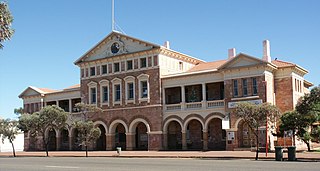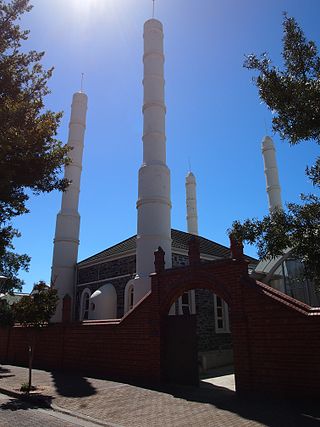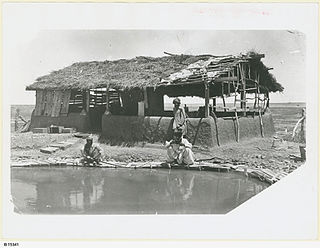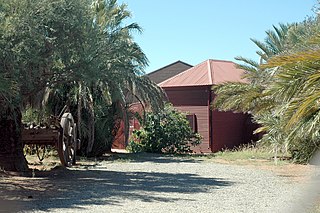
The West Australian is the only locally edited daily newspaper published in Perth, Western Australia. It is owned by Seven West Media (SWM), as is the state's other major newspaper, The Sunday Times. It is the second-oldest continuously produced newspaper in Australia, having been published since 1833. It tends to have conservative leanings, and has mostly supported the Liberal–National Party Coalition. It has Australia's largest share of market penetration of any newspaper in the country.
Dost Mohammad, Dost Mohammad, Dost Mahomet and other variants is a male Muslim given name meaning friend of Muhammad. Notable bearers of the name include:

Islam is the second largest religion in Australia. According to the 2021 Census in Australia, the combined number of people who self-identified as Muslims in Australia, from all forms of Islam, constituted 813,392 people, or 3.2% of the total Australian population. That total Muslim population makes Islam, in all its denominations and sects, the second largest religious grouping in Australia, after all denominations of Christianity.

Coolgardie is a small town in Western Australia, 558 kilometres (347 mi) east of the state capital, Perth. It has a population of approximately 850 people.

Balladonia is a small roadhouse community located on the Eyre Highway in Western Australia. It is the first stop east of Norseman on the journey east across the Nullarbor Plain. Between Balladonia and Caiguna is a 146.6-kilometre (91.1 mi) stretch of the highway which is one of the longest straight stretches of road in the world.
The Battle of Broken Hill, also known as the Broken Hill massacre, was an incident that took place near the Australian town of Broken Hill, New South Wales, on 1 January 1915. Two Muslim former camel drivers from colonial India who supported the Ottoman Empire—Badsha Mahommed Gool and Mullah Abdullah—shot dead four people and wounded seven others before being killed by the police and local vigilantes. Although the attacks were politically and religiously motivated, the men were not members of any sanctioned armed force. Three days after the attack, the pair's suicide notes were discovered by a miner. Mullah Abdullah's note suggested he was motivated primarily by personal grievances against a local food safety inspector.
Afghan cameleers in Australia, also known as "Afghans" or "Ghans", were camel drivers who worked in Outback Australia from the 1860s to the 1930s. Small groups of cameleers were shipped in and out of Australia at three-year intervals, to service the Australian inland pastoral industry by carting goods and transporting wool bales by camel trains.
Dost Mahomet, sometimes spelt Dost Mohammad, was a Baloch "Afghan" cameleer in Australia. He used his animals to transport goods between the ports and remote inland mining and pastoral settlements of the Goldfields, Pilbara and Murchison regions of Western Australia at the end of the 19th century, and owned many camels and property at Port Hedland. He was married to the Prussian-Australian Annie Grigo and they had six children. Dost became a man of wealth and standing in the community, but both he and Annie met violent deaths.
Afghan Australians are Australians tied to Afghanistan either by birth or by ancestry.

The Central Adelaide Mosque, also known as Adelaide City Mosque or Adelaide Central Mosque or Adelaide Mosque, and formerly known as the Afghan Chapel, is a mosque located in Adelaide, South Australia. The mosque was built in 1888–1889, with its four distinctive minarets added in 1903, and is the oldest permanent mosque in Australia. Located in Little Gilbert Street in the south-west corner of the Adelaide city centre, the mosque was originally built to accommodate the spiritual needs of "Afghan" cameleers and traders coming in after working in South Australia's northern regions. After the congregation dwindled and the mosque fell into disrepair in the early 20th century, it took on a new lease of life with post-World War II Muslim migration, and has since been thriving.

The Marree Mosque is a former mosque located in Marree, South Australia, Australia.

Muhammad Hassan Musa Khan, also known as Mohamed Hasan Musakhan, Hasan Musakhan, or Hassan Musakhan, was one of the early so-called "Afghan" cameleers in Australia. Born in Karachi, a member of the Tarin tribe of Pashtuns. he was a nephew of Khan Bahadur Moradkhan, the first South Asian supplier of camels to Australia. Khan was the first Ahmadiyya Muslim in Australia, and was notable for being appointed as an arbitrator in a complex 1899 court case, involving camel importation to Western Australia.

Ahmadiyya is an Islamic movement in Australia, first formally founded in the country in the 1980s, during the era of the fourth caliph. However, the history of the Community dates back to the early 20th century, during the lifetime of the founder of the movement, Mirza Ghulam Ahmad, with the first contacts arising as a consequence of Australians travelling to British India, and also as a consequence of early, "Afghan" camel drivers settling in Australia during the mid to late 19th century. Today there are at least four Ahmadi mosques in four of the six Australian states, representing an estimated 6,000-8,000 Australian Ahmadis in the country.

Broken Hill Mosque is a heritage-listed mosque and museum at Buck Street, Broken Hill, City of Broken Hill, New South Wales, Australia. It was built by Afghan cameleers. It is also known as Mohammedan Mosque and Afghan Mosque. The property is owned by Broken Hill City Council. It was added to the New South Wales State Heritage Register on 23 April 2010.

Mohamet Allum, also known as Muhammad Alam Khan and nicknamed "The Wonder Man", was an Afghan herbalist based in Adelaide, South Australia.

Gool Mahomet, also known as Gul Muhammed, was an Afghan cameleer who immigrated from Kabul, Emirate of Afghanistan, to Australia in 1887. He worked in and around Central Australia.

Sallay Mahomet, sometimes spelled Saleh, was an Afghan Australian cameleer and camel trainer who lived for much of his life at Alice Springs.
Faiz Mahomet, was an Afghan cameleer who migrated to Australia in 1870. He worked in South Australia and Western Australia, including in partnership with his brother Tagh Mahomet, and laid the foundation stone for the Perth Mosque in 1905. His wife was first cousin to the Amir of Afghanistan.
Monga Khan was a Muslim immigrant and hawker from British India who sold local and imported goods in Victoria, Australia. He travelled to Australia in search of work, although he was not one of the many men from South Asia who were indentured or brought to work in Australia in the late 19th century, that generation of settlers now collectively referred to as the "Afghans". A now-iconic portrait of him from 1916 was first used in the year 2016 by Australian artist Peter Drew, as part of a poster campaign called "Real Aussies Say Welcome". The poster featured an image of Khan with the word "Aussie" written underneath.

Fatima Payman is an Afghan-born Australian politician who has served as senator for Western Australia since 2022. Representing the Labor Party, she became the Australian Parliament's first hijab-wearing Muslim woman after being elected in the 2022 federal election.













